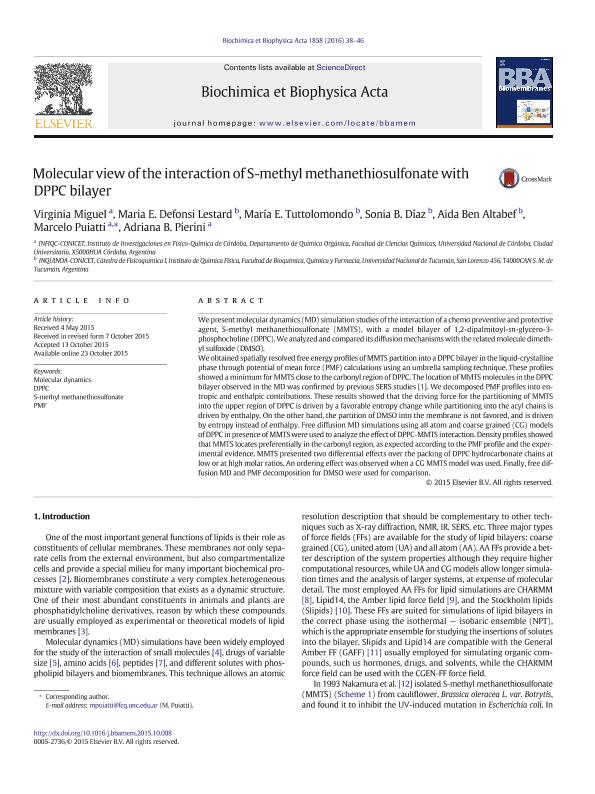Artículo
Molecular View of the Interaction of S-Methyl Methanethiosulfonate with DPPC Bilayer
Miguel, Virginia ; Defonsi Lestard, Maria Eliana
; Defonsi Lestard, Maria Eliana ; Tuttolomondo, María Victoria
; Tuttolomondo, María Victoria ; Díaz, Sonia B.; Ben Altabef, Aida
; Díaz, Sonia B.; Ben Altabef, Aida ; Puiatti, Marcelo
; Puiatti, Marcelo ; Pierini, Adriana Beatriz
; Pierini, Adriana Beatriz
 ; Defonsi Lestard, Maria Eliana
; Defonsi Lestard, Maria Eliana ; Tuttolomondo, María Victoria
; Tuttolomondo, María Victoria ; Díaz, Sonia B.; Ben Altabef, Aida
; Díaz, Sonia B.; Ben Altabef, Aida ; Puiatti, Marcelo
; Puiatti, Marcelo ; Pierini, Adriana Beatriz
; Pierini, Adriana Beatriz
Fecha de publicación:
10/2015
Editorial:
Elsevier
Revista:
Biochimica Et Biophysica Acta - Biomembranes
ISSN:
0005-2736
Idioma:
Inglés
Tipo de recurso:
Artículo publicado
Clasificación temática:
Resumen
We present molecular dynamics (MD) simulation studies of the interaction of a chemo preventive and protective agent, S-methyl methanethiosulfonate (MMTS), with a model bilayer of 1,2-dipalmitoyl-sn-glycero-3-phosphocholine (DPPC). We analyzed and compared its diffusion mechanisms with the related molecule dimethyl sulfoxide (DMSO). We obtained spatially resolved free energy profiles of MMTS partition into a DPPC bilayer in the liquid-crystalline phase through Potential of Mean Force (PMF) calculations using an umbrella sampling technique. These profiles showed a minimum for MMTS close to the carbonyl region of DPPC. The location of MMTS molecules in the DPPC bilayer observed in the MD were confirmed by previous SERS studies.1 We decomposed PMF profiles into entropic and enthalpic contributions. These results showed that the driving force for the partitioning of MMTS into the upper region of DPPC is driven by a favorable entropy change while partitioning into the acyl chains is driven by enthalpy. On the other hand, the partition of DMSO into the membrane is not favored, and is driven by entropy instead of enthalpy. Free diffusion MD simulations using all atom and coarse grained (CG) models of DPPC in presence of MMTS were used to analyze the effect of DPPC-MMTS interaction. Density profiles showed that MMTS locates preferentially in the carbonyl region, as expected according to the PMF profile and the experimental evidence. MMTS presented two differential effects over the packing of DPPC hydrocarbonate chains at low or at high molar ratios. An ordering effect was observed when a CG MMTS model was used. Finally, free diffusion MD and PMF decomposition for DMSO were used for comparison.
Palabras clave:
Molecular Dynamics
,
Dppc
,
S-Methyl Methanethiosulfonate
,
Pmf
Archivos asociados
Licencia
Identificadores
Colecciones
Articulos(INFIQC)
Articulos de INST.DE INVESTIGACIONES EN FISICO- QUIMICA DE CORDOBA
Articulos de INST.DE INVESTIGACIONES EN FISICO- QUIMICA DE CORDOBA
Articulos(INQUINOA)
Articulos de INST.DE QUIMICA DEL NOROESTE
Articulos de INST.DE QUIMICA DEL NOROESTE
Citación
Miguel, Virginia; Defonsi Lestard, Maria Eliana; Tuttolomondo, María Victoria; Díaz, Sonia B.; Ben Altabef, Aida; et al.; Molecular View of the Interaction of S-Methyl Methanethiosulfonate with DPPC Bilayer; Elsevier; Biochimica Et Biophysica Acta - Biomembranes; 1858; 1; 10-2015; 38-46
Compartir
Altmétricas



